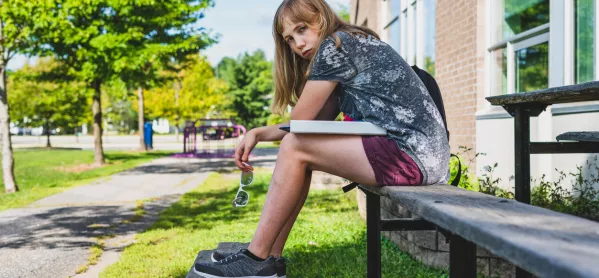- Home
- How Covid-19 has hit US schools: a teacher’s view
How Covid-19 has hit US schools: a teacher’s view

Before the governor officially closed New Jersey schools on 18 March, tensions were high and people were scared.
As a high-school teacher, and several months pregnant, I was afraid I would have to choose between my job and my safety. Fortunately, I didn’t have to make that decision. My school decided to close several days before the governor’s mandate.
Read more:
- How Dutch schools reopened with no pupil distancing
- How Danish schools made social distancing work
- Do secondary students in the UK want to go back to school?
Schools in New Jersey will be closed through this school year, and it’s questionable as to how they will resume in September. But my colleagues and I are worried we may be forced to once again choose between our health and our jobs when that day comes.
I teach in a wealthy school district that has ample resources and supplies. Students who need laptops have been loaned ones, tech support is offered to anyone with problems, and internet access is available in every home. We use so much technology in the classroom already, so it wasn’t difficult to ask students to do so at home. I have video classes with my students once a week and individual video chats with struggling students.
Taking its toll
This style of teaching has been an incredible burden on teachers who are also parents. They are being asked to work a full-time job, while also homeschooling and supervising their own children. Any parent currently working at home knows this juggling act.
It’s been tough for everyone. A few of my students have caught Covid-19 and some have lost family members, whom they’ve had to bury without funerals. How can I ask a student to work on their essay when they’re grieving in this way?
My students were looking forward to graduation, prom, and other celebrations, all of which have been cancelled. They need room to grieve all that they’ve lost in these past few months.
Pupil burn out
As the year winds to an end, my colleagues and I are starting to see burn out among our students. In video class, we’ve noticed fewer kids talking and more kids preferring to turn their camera off. We’re unsure how to tackle controversial topics in class in a virtual setting. How do we have a sensitive and intellectual discussion in a video class about racial injustice and the protests currently occurring?
We feel as if we’re fighting so many battles at the same time: a global pandemic, emotional and social isolation, and a national crisis, all while under the leadership of an incompetent president.
Other schools in the US have it much worse. My friend who teaches in Philadelphia gave paper packets to her students before remote learning began, and she hasn’t talked to her students since. Many of them do not have devices to access the internet, and the schools are unable to provide technology.
Widening inequality
This pandemic has certainly exposed inequality in American schools. Wealthy students are continuing to progress in their education, while poorer students are being left behind.
On 4 May, the American Enterprise Institute published a study outlining how schools should safely reopen. It states that schools should develop plans based on the following:
- Schools will open in September but may shut again temporarily if there is an outbreak.
- Reopened schools will need to implement modifications such as physical distancing, temperature screenings and frequent disinfecting of classrooms.
- Accommodations will have to be made for students and staff who may be at heightened risk due to age or health concerns.
- A vaccine may not be available for at least 18 months, so these plans may have to be implemented for the 2021-2022 school year as well.
According to this report, schools should also understand that, while the governor can open and close schools, those decisions can also be made by local leaders.
Schools will be responsible for meeting the needs of students with disabilities, English language learners and those from low-income backgrounds.
Worries about the future
In an ideal world, we would all be able to follow the recommended guidelines about how to safely open schools in September. Unfortunately, due to inequality in US school systems and a lack of support on the federal level, not all schools will be able to do this successfully.
Families and teachers may have impossible choices to make in September. We will be struggling with the effects of this virus for years to come.
Rebecca McGrath is a high school teacher in New Jersey, US
Keep reading for just £1 per month
You've reached your limit of free articles this month. Subscribe for £1 per month for three months and get:
- Unlimited access to all Tes magazine content
- Exclusive subscriber-only stories
- Award-winning email newsletters



